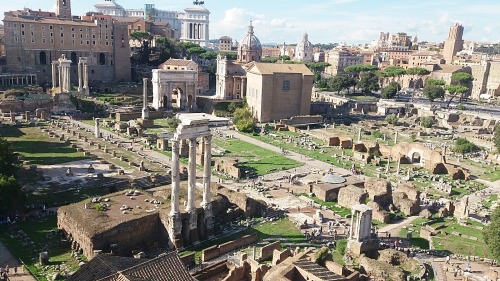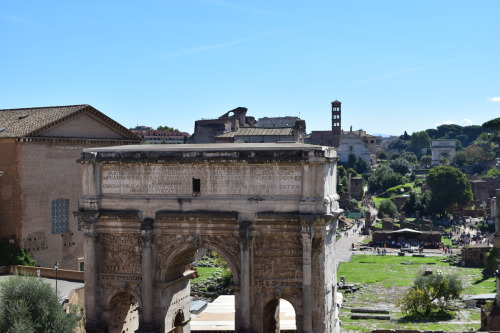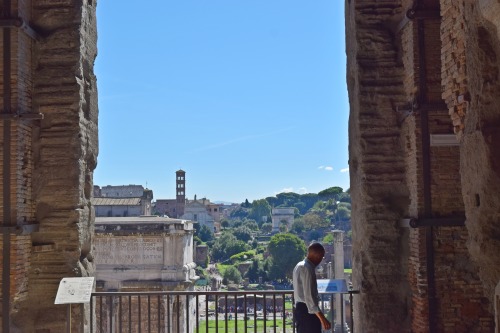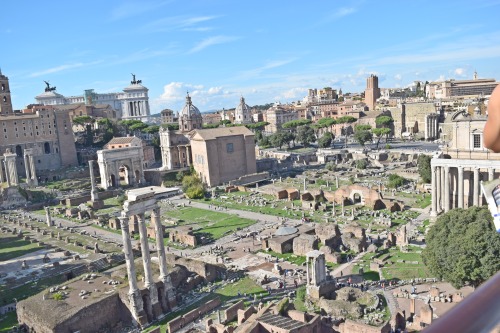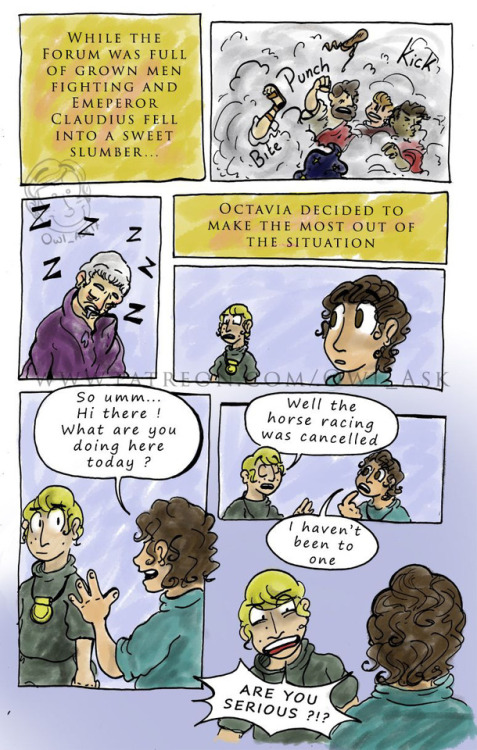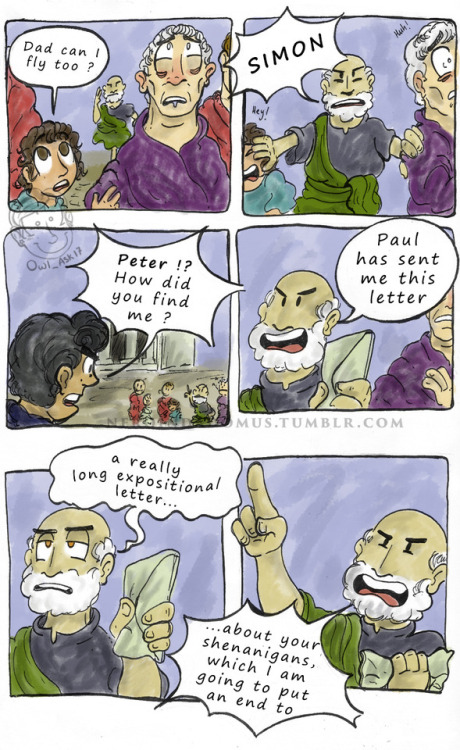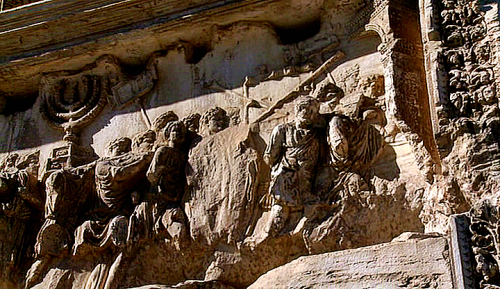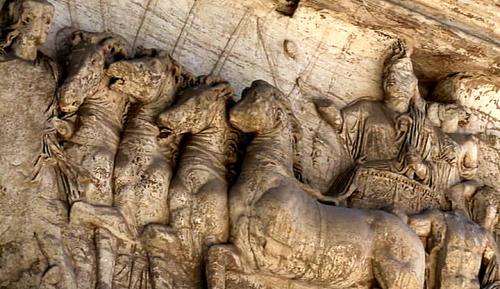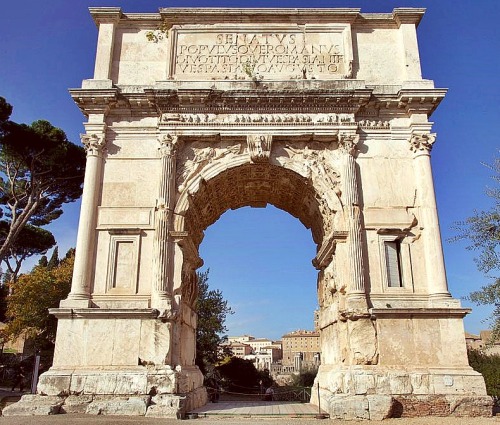#forum romanum
Chapter 6: Holding Court
Having finished with clients, Cicero and I stepped out into the bright morning light with the usual string of clients in tow.

The senator walked quickly down the street, taking us from the leafy heights of the Esquiline Hill and into the smoke and stink of the Subura.

Cicero was a well-known figure here, a hero to the shopkeepers and merchants whose interests he had represented, and the people waved and called out warmly as we passed. Without breaking his step, Cicero acknowledged each bowed head, wave or greeting, and, while I was always ready to whisper names into his ear, I rarely that I needed to. He knew his voters far better than I.

Finally, we entered the Forum Romanum, where the crowds were growing by the moment. I don’t know how it is today, but in those days there were always six or seven law courts in almost permanent session, each set up in a different part of the forum. By the time each of these courts convened, the forum was packed with advocates, legal officers and spectators come to hear the cases of the day, which always made for good entertainment.

By chance, we emerged into the forum as Quintus Hortensius Hortalus, Cicero’s primary rival and the recognized best lawyer in Rome, passed by with his legal team. Due to his rank and reputation, Cicero was forced to stop and wait. The patrician barely registered or acknowledged my master’s presence, which left Cicero irritated; obviously, Hortensius did not feel the need to acknowledge someone he felt was beneath him.

Our business this morning was in the central criminal court, which convened outside the Basilica Aemilia, where the fifteen-year-old Caius Popillius Laenas was on trial, accused of stabbing his father to death. Cicero was due to make the closing speech for his defense, and, if he failed, Popillius would be stripped naked, flayed until he bled, sewn up in a sack with a dog, a cock and a viper, and thrown into the River Tiber.

“We really must secure an acquittal,” Cicero whispered to me as we approached. “If only to spare the dog, the cock and viper the ordeal of being sewn up in a sack with Popillius.”

Cicero stopped to talk briefly to his client. He didn’t care for the boy, of course, so he didn’t care whether or not he was guilty. He undertook only to do his best, and, in return, the Popillii Laeni, a family which boasted four consuls within its family tree, would be obliged to support him whenever he ran for office.
As I sat down at the defense table, Cicero quickly scribbled something on a piece of parchment, which he then handed to me.

“Say nothing to our Sicilian friend,” he said. “Take this to the chief clerk at the Senate House and see if you can get it on today’s agenda.”

I ran as fast as my legs would carry me, wishing to complete my errand in time for my master’s closing speech.

It was not until I was almost to the Senate House that I glanced down at what he had written: That in the opinion of the House the prosecution of persons in their absence on capital charges should be prohibited in the provinces. I felt a tightening in my chest, for it amounted to nothing less than a declaration of war.
Ancient Worlds - BBC Two
Episode 6 “City of Man, City of God”
TheArch of Titus (Arcus Titi) is a triumphal arch located at the entrance to the Forum Romanum, at the highest point of the via Sacra.
The arch was constructed in 81 AD by the Roman Emperor Domitian shortly after the death of his older brother Titus (Emperor from 79 to 81 AD) to commemorate the victories of his father VespasianandTitus in the Jewish WarinJudaea.
In 66 AD Jewish Zealots started a revolt against the Roman occupation of Judaea. Vespasian was sent from Rome to suppress the revolt. After Vespasian became emperor, his son Titus took over command of the troops. The siege of Jerusalem in 70 AD was the decisive event of the war. The city was sacked, its famous Second Temple destroyed and its vast riches plundered.
The original inscription on the east side of the arch is still in situ. Originally the letters would have been inlaid with gilded bronze. It reads:
“SENATUS POPOLUS QUE ROMANUS DIVO TITO DIVI VESPASIANI F(filio) VISPASIANO AUGUSTO” - The Roman Senate and People to the divine Titus Vespasianus Augustus, son of the divine Vespasian
The south panel depicts the spoils taken from the Temple in Jerusalem, carried on litters in a triumphal procession, amongst then the silver trumpets and the seven-branched golden Candelabra(Menorah), carved in deep relief. The north panel depicts Titus as Triumphator,riding a four-horse chariot (quadriga) and shows him being crowned by a personification of Victory.ThegoddessRoma stands in front, holding the bridle of one of the horses. This is one of the first examples of divinities and humans being present in one scene together.
The arch of Titus is one of Rome’s oldest and most well preserved arches. It has provided the general model for many triumphal arches, like the Arc de Triomphe in Paris, France.
Post link
FORUM ROMANUM VI





TEMPLUM DIVI VESPASIANI
The Temple of the Divine Vespasian was begun by Titus after the death of Vespasian in AD 79, but finished and dedicated by Domitian after the premature demise of Titus in AD 81. Some scholars have hypothesized a dual dedication to both the deified Vespasian and Titus. The inscription on the architrave (recorded in the Einsiedlen Itinerary), however, cited Vespasian only (DIVO VESPASIANO AVGUSTO S. P. Q. R.). The Temple of the Divine Antoninus Pius and Faustina cites both dedicatees in that temple’s surviving inscription, which suggests that Titus would have been mentioned had his cult been established in the same temple as his father’s. The omission of Titus may attributed to Domitian’s hostility towards his brother or to the fact that Titus’ death had been commemorated in the Forum already by the arch bearing his name.
The Temple of the Deified Vespasian is sited in the highly-congested western end of the Forum Romanum, between the Temple of Concordia and the Temple of Saturn. When complete, it nearly abutted the Tabularium and obscured much of its façade. The previous temples of the imperial cult, dedicated to Augustus and Claudius, had been built outside the forum where sufficient land allowed for the construction of imposing edifices. The Flavians, however, chose this chose this cramped space in order to establish a dynastic presence in the Forum. The temple would also serve as a counterweight to the Temple of the Deified Julius Caesar, which stood at the eastern end of the Forum, and to the other monuments built by the Julio-Claudians. The site did have one advantage: located at the foot of the Clivus Capitolinus, the temple was highly visible during triumphs and other civic ceremonies that terminated on the Capitoline Hill.
The temple is hexastyle, prostyle and pseudo-peripteral. It stood on a high, marble faced podium and had a façade orientation. The odd proportions of the temple (33 m x 22 m) were dictated by the area available. The scant physical remains consist of the podium, three fluted Corinthian columns supporting a section of the architrave, and, inside the Tabularium, a large chunk of the entablature.

The latter is virtual compendium of Roman decorative motifs including dentilation, egg and dart, rosette coffering, brackets, and a large frieze depicting bucrania and the implements used by the priests of the temple in the performance of sacrifices. Dense, ostentatious ornamentation is a hallmark of Flavian style, perhaps reflecting desire of the usurping dynasty to project an image of richesse.
A second inscription, also preserved in the Einsiedeln Itinerary, appears on the architrave, the final word of which is still extant:
IMPP. CAESS. SEVERVS ET ANTONINVS PII FELIC[ES] AVGG. RESTITVER[ENT]
Archaeological evidence suggests that the restoration of the temple around AD 200 by Septimius Severus and Caracalla was minor act undertaken for its propagandistic value of linking the Severus to the previous—and highly-admired—usurper, Vespasian.
The temple was largely demolished by Nicholas V as part of his reorganization of the Forum Romanum.
FORUM ROMANUM SERIES
I. Arch of Titus
II. Lacus Juthurnae
III. Arch of Septimius Severus
IV. Tabularium
V. Basilica Iulia
VI. Templum Divi Vespasiani

